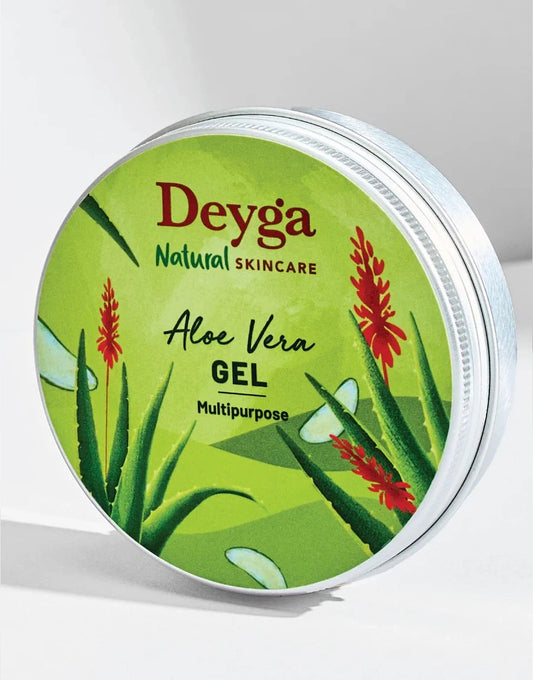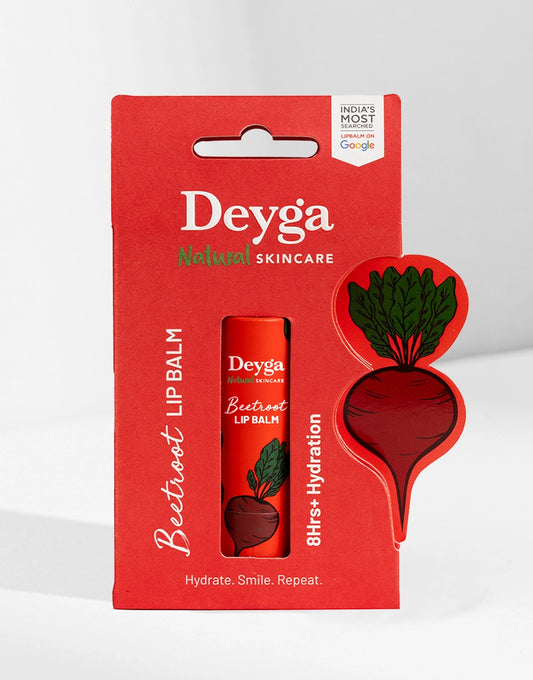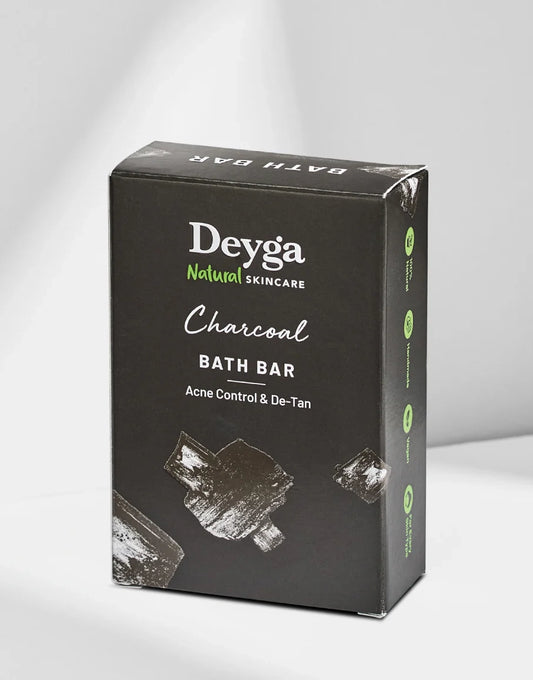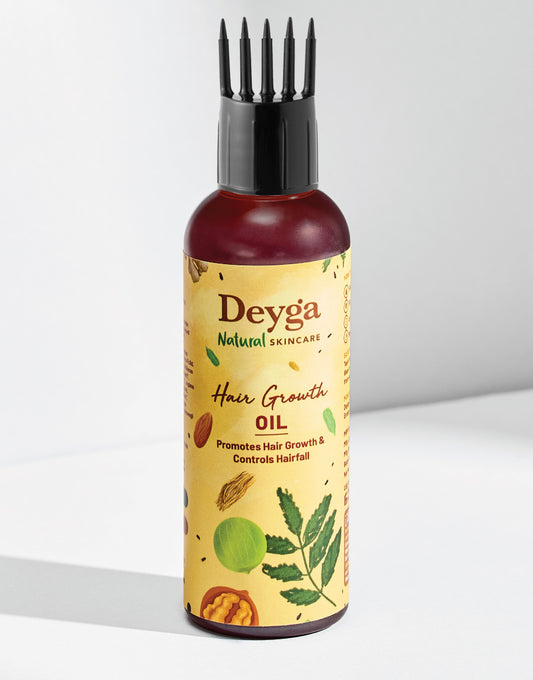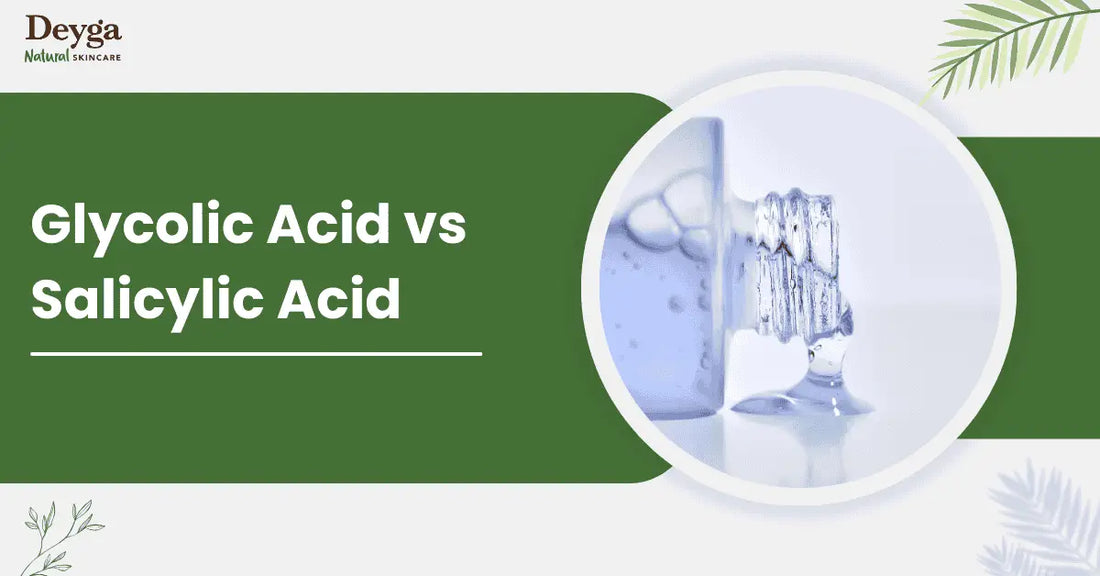Confused in choosing between Glycolic acid Vs Salicylic acid? A confusion you get just like everyone of us. They both are chemical exfoliating agents in skincare, which performs differently. You can choose knowing which skin type and concern they will work on.
If you want to know which one will suit you. Dig here in detail to know about Salicylic Acid and Glycolic Acid in detail below. From this blog, you will get to know which one suits you the most!
Salicylic & Glycolic: What and How
Glycolic Acid (AHA): How It Works

-
Glycolic acid is a water soluble, AHA based, which focuses on smallest molecular sizes. These small sized molecules help in penetrating closer with the skin surface. They further break down to hold the dead skin cells together.
-
Using AHA helps in improving the texture of skin, works on skin’s rough patches, fades away the spots and pigmentation marks on the skin. They focus on the EPIDERMIS, which is the surface. If not used properly, they may lead to skin irritation and redness.
Salicylic Acid (BHA): How It Works

-
Salicylic acid, also known as BHA, is oil based. They focus on penetrating deep into the pores to dissolve excess oil secretion and unclogs pores. They are rich in anti-inflammatory and anti-microbial properties.
-
Incorporating BHA, works on acne, blackheads, and oily areas. They calm irritated and congested skin. According to healthline, over-using may lead to excess dryness and skin irritation, especially when you have weak skin barrier.
Glycolic Acid vs Salicylic Acid : Key Difference
Which is Better? Glycolic Acid or Salicylic Acid
-
Glycolic Acid suits you, if you want even skin toner, pigmentation-free skin, and without any signs of ageing.
-
Salicylic Acid suits you, if you suffer from skin breakouts, blackheads and clogged pores.
-
Patch test if you are using it for the first time.
-
If you have sensitive skin, start with a lower percentage. Also use them once a week, and not everyday.
-
When you are using any exfoliators, make sure to hydrate your skin well with a moisturizer or serum.
-
Leaving on products works better than washing off products. So, choose serums, rather than cleansers
-
Once after cleansing, use any of the exfoliating acid, and layer with moisturizer. Never miss sunscreen in your AM routine.
Can Glycolic Acid and Salicylic Acid Be Used Together?
Yes, only if you are not a beginner with exfoliants. Here are some of the advantages and dis-advantages of using them together.
Advantages:
-
You get benefits for both surface issues (texture, tone) and pore/clog issues (acne)
-
You can mix and match with the products in your routine. Like salicylic acid based cleanser and glycolic acid based toner or serum
Disadvantage:
-
Since both are exfoliating products, too much usage leads to skin dryness and damage to the skin barrier.
-
Increased sun sensitivity.
-
Using too much concentration at a similar time might lead to skin irritation.
Safe Ways to Combine
-
Use them on alternating nights.
-
You can incorporate all like SA as a cleanser in the morning, glycolic acid as toner, and use exfoliants if your skin tolerates it.
-
Keep concentrations minimal, and gradually increase them.
-
Always follow up with moisturiser and daily sunscreen.
Real-World Use: Examples & Case Insights
Here are a few scenarios based on real-user / derm guidance:
Case A: Acne Pigmentation, Post Acne Scars, & Oily Skin

Incorporating 2% salicylic acid based cleanser daily or once in two days helps. Never miss sunscreen while using the acids. After a period of time, you will see the reduction in breakouts and pigmentation fades away.
Case B: Dry Skin, Damaged Skin, & Fine Lines

Using 5% glycolic acid every three days, with the right moisturizer, helps in congested skin. Increase the usage once your skin sets using acids.
Case C: Combination Skin

Use salicylic acid on the T-zone (spot treatments / localized) and glycolic acid over the cheeks for tone/texture. Or alternate nights. Listen to what skin is telling you.
Precautions and Side Effects When Using these Acids
-
If you are using it for the first time, never miss a patch test on your jawline.
-
Never mix these with strong and active ingredients like retinols.
-
Always use SPF in your AM routine, no matter if you are indoors or outdoors.
How to Safely Introduce Exfoliating Acids into Your Skincare Routine?
-
Identify your skin type initially
-
Pick the right acid between salicylic and glycolic acid.
-
Start with a lower percentage, use them once in a week, depending on your skin.
-
Check for the changes happening in your skin, and check if you have irritated skin
-
Add the other acid, only if it's needed.
Conclusion
Between glycolic acid and salicylic acid, both are completely different and suit certain skincare concerns. Using them together gives better results, but make sure to be cautious. Do not over exfoliate your skin, since they will dry out and cause irritation and breakouts.
Ensure to start slowly, once or twice in a week, and gradually increase. If you face any skin irritation, make sure to consult your dermat to prevent further skincare concerns.
FAQs:
Can I use glycolic acid and salicylic acid together in the same skincare routine?
Yes, but with caution. Make sure to start with one acid, and once after skin is used to it, you can incorporate other acid.
Which acid is better for dark spots and hyperpigmentation?
Since it is on the skin surface, you can use glycolic acid based serum.
Does salicylic acid dry out the skin more than glycolic acid?
Yes, salicylic acid tends to dry skin, since they penetrate deep into the skin. So, never miss moisturizing the skin.
What concentration of glycolic or salicylic acid is safe for beginners?
For glycolic acid, go with 5–7% for beginners. And for Salicylic acid, use 0.5–2%.
How long before I see results from using these acids?
If you use them consistently, you can see visible results in 4 weeks to 8 weeks.
Are there any skin types that should avoid glycolic or salicylic acid entirely?
If your skin is too dry or sensitive, avoid incorporating these serums in your routine.
Can I use acids if I have sensitive skin or rosacea?
Yes, but start with a minimum percentage. Also patch test before using all over your face.
How do I layer acid with other strong acids like retinol or vitamin C?
It is not recommended to layer acids. You can use it on alternate days or in either one skincare routine.
When should I apply sunscreen in acid-based skincare routines?
Since acids are generally sensitive to skin, you should use SPF in the morning/AM routine.
Are there adverse interactions or side effects if I overuse these acids?
Yes, over-using may lead to skin redness, itchiness, and even dry out your skin.

